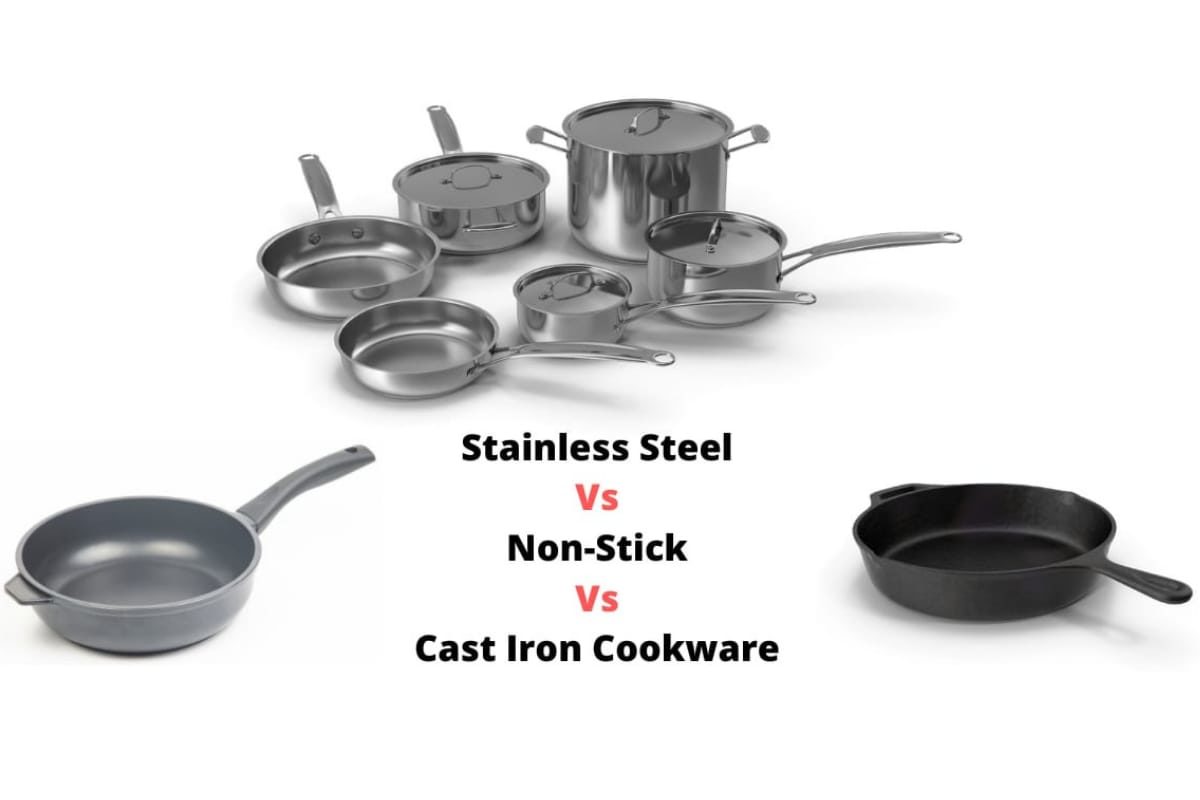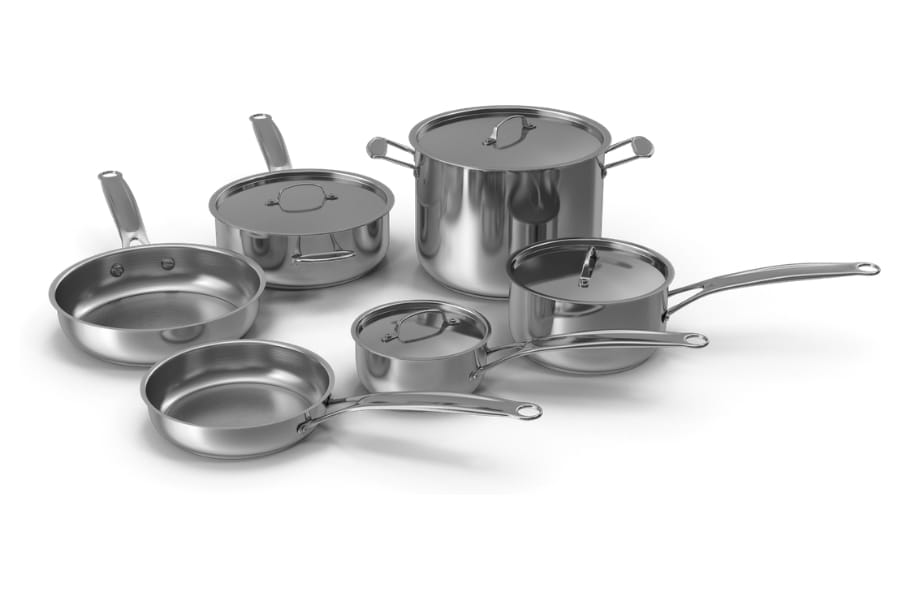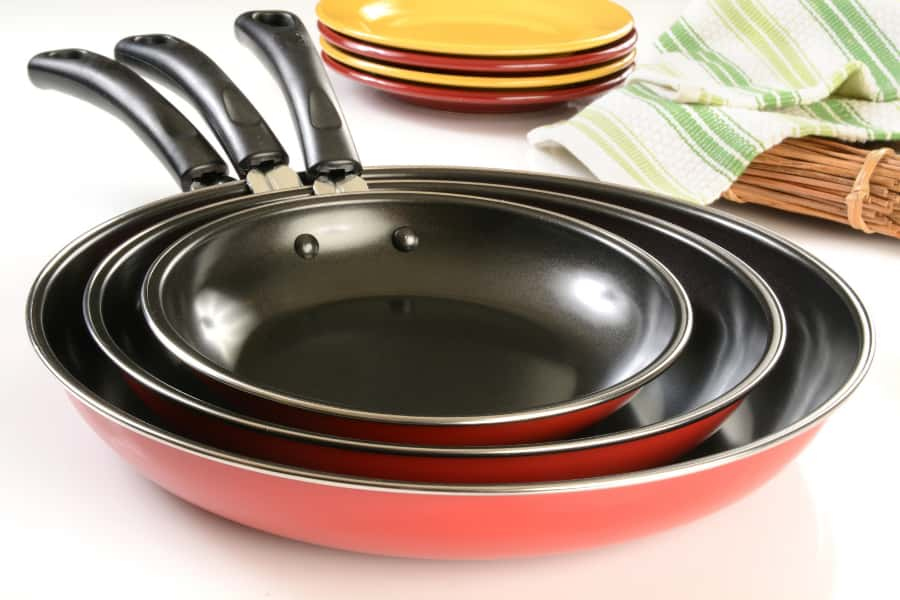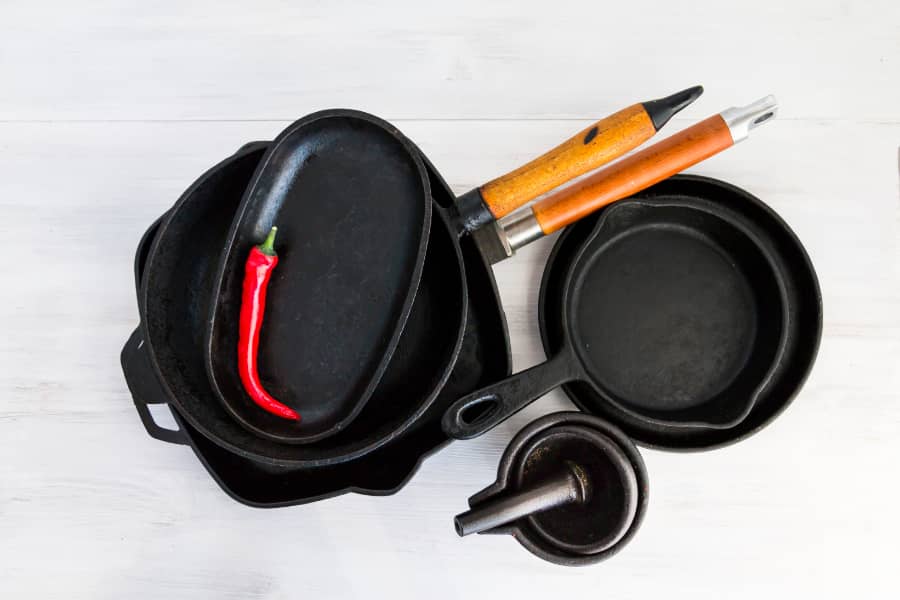There are three types of most popular materials for cookware- stainless steel, non-stick, and cast iron. People prefer to use stainless steel as it is rust-free material and food-safe. Stainless steel is used in pans, kadais, pressure cookers, cutlery, cookware, and major kitchen appliances.
Non-stick cookware doesn’t allow the food to stick to the surface and makes cooking hassle-free. A non-stick pan needs very little oil to cook.
Cast-iron cookware is an excellent material for cooking foods. It can absorb the heat well, retain the warmth, and distribute the food evenly across the width and length of the cookware.
By comparing stainless steel vs non-stick vs cast iron cookware, you will understand their differences, applications, usability, and cost to find the best one.

Stainless Steel Vs Non-stick Vs Cast Iron Cookware
| Point Of Difference | Stainless Steel Cookware | Non-stick Cookware | Cast Iron Cookware |
|---|---|---|---|
| Way of Using | Preheat the pot before cooking, then add oil to cook the food. | It can cook food fast and can retain the flavor. | It takes a bit more time to heat the pan for cooking. |
| Application | Used for cooking different types of dishes. | Used for cooking food items like meat, vegetables, eggs | Used for slow cooking recipes like slew, soup, etc. |
| Food Safety | It is safe to use for any food item. | It is food-safe under some certain conditions. | Cast iron takes a long time to cook but provides healthy food. |
| Maintenance | Easy to Maintain. | It is also easy to clean. | Takes more effort to maintain. |
| Cost | Costlier than non-stick and cast-iron cookware. | Less costly than stainless steel cookware. | Cheapest among all. |
| Ease of Use | Convenient for cooking. | It is easiest to use. | Handling a cast iron cookware needs some experience. |
How can a Stainless Steel Cookware Help You?
For kitchen accessories, stainless steel is an excellent option. It is used in cookware and cutlery sets, and less tensile steel is used for sharp edge blades, knives, and other sharp-edged materials. The lower quality stainless steel is often used to form saucepans, grill pans, kitchen sinks, or cookers.
Stainless steel is an excellent option for food preparation and storage, and it can retain the flavor of the food without spoiling it. Interestingly, stainless steel is also used for ice cream production.

Advantages of Stainless Steel Cookware
Stainless steel is always a popular choice for a kitchen. It would help if you preheated the pan to ensure that the surface is slick before using it. A sleek surface is needed for making crispy food which you can get with the best stainless steel cookware in India. Also, stainless steel does not react with acidic ingredients like vinegar or tomatoes, and thus, it is ideal for cooking them. A heavy bottom stainless steel kadai can be used to disperse and maintain the heat uniformly.
What is Non-stick cookware’s Specialty?
To scramble eggs or fry any ingredient, use a non-stick skillet or saucepan. Non-stick cookware is ideal for cooking delicate and soft fish pieces or pancakes. If you want to make custard or rice, a non-stick pan is a way to go. Most ingredients are healthy to cook in them. To avoid damaging the base, use wooden utensils or heatproof spatulas. All the more, the non-stick cookware is simple to clean.

Advantages of Non-stick Cookware
Non-stick cookware is a slick and non-reactive accessory, and its non-reactive surface prevents food from sticking to the pan’s surface. Cooking on the best non-stick cookware in India often gives you the same taste or even a better want with olive oil. So, it’s time to treat your guests with utterly healthy and lip-smacking dishes sauteed on non-stick cookware.
Why is Cast Iron Cookware also important?
It is an age-old material that has recently gained popularity. Cooking on cast iron pans and pots is a pleasurable experience. It is dependable, non-toxic, long-lasting, non-sticky, and has many plus points to defend it.
You can make a juicy fillet mignon for lunch or chocolate chip cookies for dessert. What’s more, you can cook with it until and unless your cast iron skillet is seasoned and rust-free. You can cook delicious and flavourful dishes of your choice with the best cast iron cookware in India for many years to come by.

Advantages of Cast Iron Cookware
Cast iron cookware is worth the time and effort because of its non-reactivity to the food ingredients. It is also naturally non-stick and serves the purpose of non-stick cookware. You can use cast iron skillets, pans, and kadais to make almost any kind of food with a better taste.
Differences of Stainless Steel, Non-Stick and Cast Iron Cookware
Understanding the difference between stainless steel, non-stick, and cast iron cookware can help you choose a suitable utensil for cooking unique dishes. Browning ingredients are best done in stainless steel cookware, and cooking delicate foods in non-stick pots and pans is the best option. On the other hand, cast iron cookware has a natural non-stick surface. Let’s see the differences in their properties in detail.
Stainless Steel Vs Non-Stick Vs Cast Iron Cookware: Usability
Stainless Steel Cookware
Cooking in stainless steel pots and pans is the perfect kitchen workhorse for various reasons. Cookware made of stainless steel is lighter and more durable, and it does not react to any foods. Stainless steel is a good material, and you can easily use it for various cooking tasks.
A stainless steel pan should be preheated before cooking. After 2 to 3 minutes, add a thin layer of oil into the pan. You can check if the pot is hot enough. Put a drop of water in the pan, and if the water splits into many droplets and evaporate, you are good to go.
Stainless steel cookware is prone to sticking to the bottom of the surface. However, you can avoid that. When cooking, continue to heat your stainless steel pan until the oil starts to smoke. Take away the pan from the heat, allow it to cool and then start your cooking. When it starts simmering, your pan is ready for cooking.
Non-stick Cookware
If you have a non-stick frying pan or a regular pan, you can cook food faster, that too, by retaining the flavor. A non-stick piece of equipment in your kitchen is probably the best to use less oil or fat in your diet.
Non-stick cookware or skillet is usually made of aluminum, which is a good heat conductor. Therefore, if you use a heavy bottom pan, there will be less risk of overheating the pan. Teflon, a chemical mixture, is used as the surface protector of the cookware.
You may be looking for ways to save time in your busy schedules and a long list of jobs. So, non-stick cookware is best to fry, stew, sauté and bake with less fat and less mess.
Cast Iron Cookware
Cast iron skillet or cookware is a boost to the kitchen. Sometimes you may find that it has outlived its user. Surprised? Well, it’s true! Cast iron pans are rough, but you can use them for many years. Cast iron cookware has been high-demanding cookware in Indian kitchens.
The traditional chefs prefer to use it for cooking purposes. Cast iron pans are hardy and indestructible. If the cast iron cookware becomes old or rusted, you can also change it or repair it. Some people even have cast iron cookware from the time of their parents or grandparents.
Cast iron cookware is great for roasting vegetables or searing meat, and you can also make some sweet recipes on them. Cast iron is widely used in making the best tawa for roti and chapati in India.
Stainless Steel Vs Cast Iron vs non-stick cookware: applications
Wide Applications of Stainless Steel Cookware
No wonder stainless steel is an invaluable material. Its versatility shows how the material lends itself to multiple industries, including medical, construction, and kitchen equipment. Stainless steel can be found in almost all Indian kitchens.
Stainless steel has a bright and clean aesthetic. But more importantly, it boasts durable, non-reactive, and hygienic quality. These benefits of stainless steel cookware have made it a desirable material for cookware, utensils, and bakeware in a dynamic kitchen.
There are a variety of stainless steel grades that are used in different food service establishments. It is very much resistant to corrosion and rusting. For this reason, stainless steel is perfect for use in the kitchen. Food-grade stainless steel is mainly used as a kitchen utensil, and it is costly to replace.
Due to its high corrosion-resistant quality, you can easily replace your equipment. This material is exceptionally sturdy as well, and you can use this excellent material for shelving and storage areas.
Limited Applications of Non-stick Cookware
People from all around the world use non-stick pans for their day-to-day cooking. Non-stick cookware is coated with Teflon, a synthetic chemical of fluorine and carbon atoms.
This Teflon coating provides a non-stick, non-reactive, and frictionless surface, and these help in flipping pancakes, turning sausages, and frying eggs without sticking to the bottom.
With other pans, you need to put some fat or oil to prevent the food from sticking to the surface, but a non-stick pan does not require it. Non-stick cookware is easy to clean because the food residues do not adhere to the pan’s surface.
Cast Iron Cookware Have a Few Applications
Cast iron cookware is valued for its heat retention and cooking at a very high temperature. Seasoning helps to protect the bare cast iron from rust.
People prefer to use cast iron cookware to withstand and maintain a high temperature. Cast iron cookware is the best option for long-cooking dishes like stews or braised dishes. You can use a cast-iron skillet for frying potatoes or star fries.
Stainless Steel Vs Non-Stick Vs Cast Iron Cookware: food safety
Stainless Steel Cookware is safe
According to the research, stainless steel is considered a safe material for food contact. The risk is minimal until you use poorly made stainless steel cookware. In that case, the cookware may leach a small amount of nickel into food.
High-quality stainless steel has varied features and is much safer to use than low-quality materials. The stainless steel cookware provides a heat-resisting surface that does not react with food, flake, or not even leaches harmful chemicals into food. Stainless steel is professional-grade cookware or utensils at affordable prices.
Non-stick Cookware is Slight Risky
Cooking in non-stick cookware is safe and healthy. But it becomes unsafe when your non-stick cookware gets overheated. When the temperature goes too high, the smaller chemical fragments are released, mixed with the food making the non-stick cookware a little risky.
If the Teflon of the non-stick cookware is heated more than 300 degrees Celsius, it releases fumes dangerous for health. But we usually cook below 200 degrees Celsius in regular cooking, and thus, no need to be worried about it.
Cast Iron Cookware is the Safest
Cast iron cookware is used for a more extended period, and it is the safest cookware amongst the three different cookware to use. This is because they do not contain or leach any harmful chemical unsafe for foods.
Ease of Cleaning and Maintenance
You need to wash stainless steel cookware with warm, soapy water along with ¼ cup of vinegar to remove traces of manufacturing oils. Rinse the cookware thoroughly, then dry with a soft towel. For non-stick stainless steel cookware, you need to wipe the oil with a soft cloth.
If the food begins to stick to the pan, you must repeat the conditioning process every 2 to 3 months.
On the other hand, Non-stick cookware’s cleaning process is straightforward. Allow your non-stick cookware to cool completely before immersing in water. You have to take a few minutes to hand wash your non-stick pans in hot soapy water, rinse well and dry completely with a soft towel.
Use a sponge, plastic scrub, or dishcloth for cleaning the pans for proper maintenance. Never use abrasive scrubbers or harsh detergents and cleaners.
Clean your cast iron cookware by hand. You can use soap and a pan scraper to clean the cookware. If any food is stuck on the pan base, a scraper can remove it. If you want to remove the stubborn grease, then simmer a little water and use the scraper after cooling the pan.
Cast Iron Vs Stainless Steel Vs Non-Stick Cookware: cost
- Stainless Steel Cookware: The cost of stainless steel cookware set ranges from a minimum of ₹900 to over ₹5000.
- Non-stick Cookware: The cost of non-stick cookware ranges from a minimum of ₹1000 to over ₹3500.
- Cast Iron Cookware: The cast iron cookware from a minimum of ₹500 to over ₹2000.
Ease To Use
Stainless steel cookware is very simple to use. You have to keep in mind that using metal utensils will leave scratches at some point in time. Though it will not affect cooking, it will affect the appearance. If you want to maintain your cookware’s pristine finish and polished look, it is recommended to avoid sharp or harsh material to use while cleaning the cookware.
Non-stick cookware means easy to handle and less work to maintain. It is easy to use because of less sticking of food, less mess, and lesser clean up. It is better to avoid using non-stick sprays because they cause an invisible build-up that impairs the non-stick release. Thus, the food will stick to the cookware.
Cast Iron Cookware is also straightforward to use. After cooking-
- Clean it with hot soapy water and a non-metallic brush.
- Rinse it thoroughly and dry it with a soft towel.
- Apply any cooking oil to every part of the cast iron cookware using a paper towel or a soft cloth.
So, which is the best among Stainless Steel, Non-Stick, & Cast Iron Cookware?
All of stainless steel, non-stick, and cast-iron cookware are food-safe and suitable for cooking. There are several differences among Stainless Steel Vs Non-Stick Vs Cast Iron Cookware in the way of use, durability, quality, food safety, applications, cleaning, and maintenance. We recommend stainless steel as the best option, followed by cast iron and non-stick cookware.
Related Posts:
